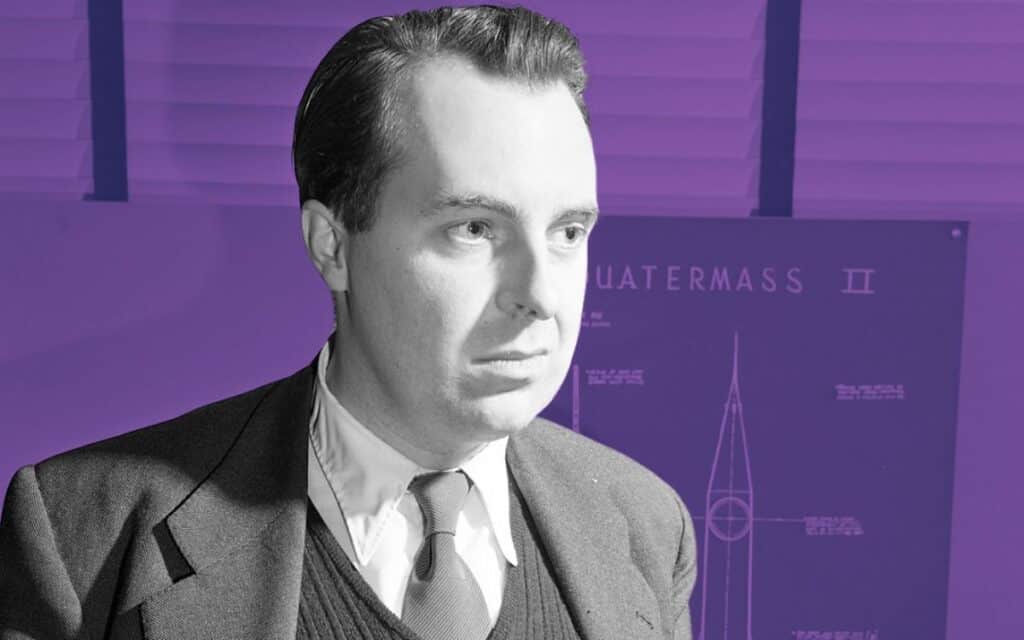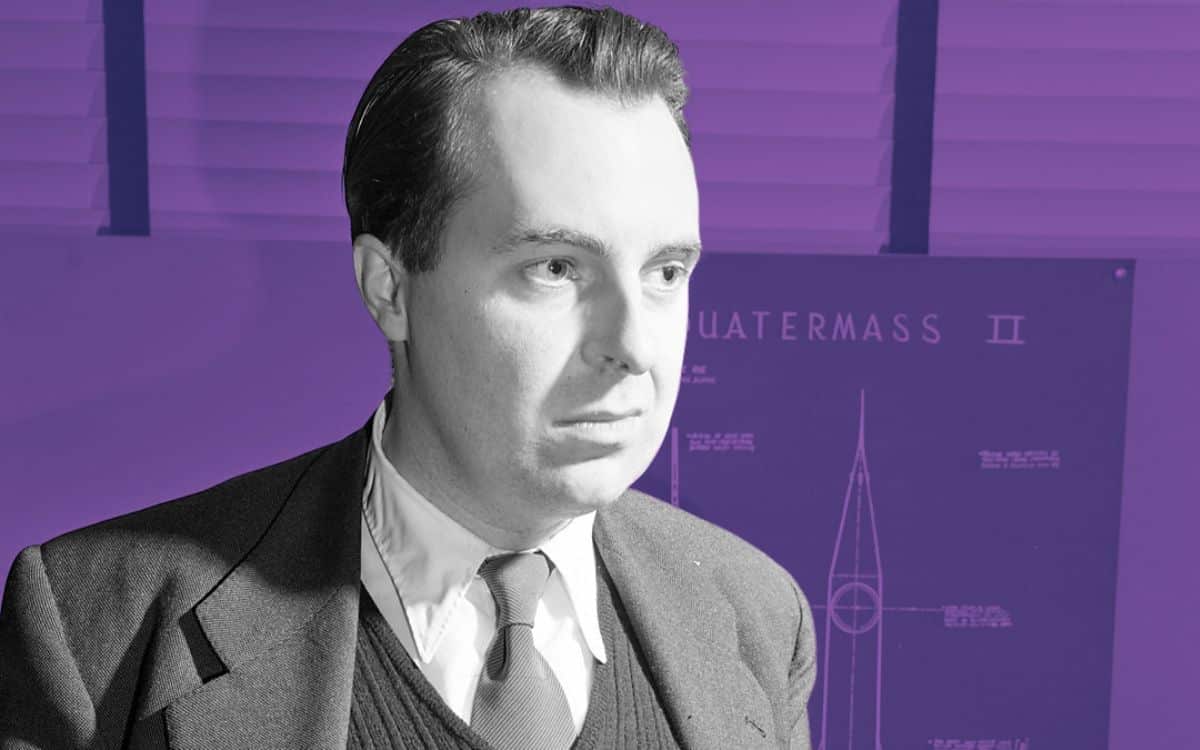Nigel Kneale’s pioneering work not only revolutionised television horror but also critically examined the implications of advancing technology, writes BRONTË SCHILTZ

When Nigel Kneale was hired as one of the BBC’s first two television staff writers in 1951, the medium was in its infancy.
Regular broadcasting had begun in Britain in 1936 but had ceased for the duration of WWII and not returned until 1946.
In the first year of Kneale’s employment, there were just 763,000 active television licenses, and television did not reach the Isle of Man, from which Kneale hailed, until October of that year.
But, over the next four decades, Kneale not only demonstrated an instinctive grasp of the power – and perils – of the medium, but also shaped its role in Britain’s cultural landscape for years to come.
It was 1953’s The Quatermass Experiment that launched Kneale into the public consciousness.
The programme follows Professor Bernard Quatermass, head of the British Experimental Rocket Group, after an exploration mission fails, the spacecraft veering off course and returning with just one of three crew members left on board.
Only the first two of the six episodes were recorded, though the rest survives via scripts, a 1955 Hammer film adaptation titled The Quatermass Xperiment and a 2005 live remake.
In the finale, Kneale made full use of the medium, staging the climax, in which Quatermass confronts a mutated alien life form evolved from his crew, in Westminster Abbey during a diegetic live broadcast.
The setting is significant – the previous year, Queen Elizabeth II’s Coronation had been held in the Abbey, its broadcast resulting in the mass purchase of television sets and licenses.
There is a knowingness, then, in Kneale’s transformation on this former site of celebration via the new medium of television into one of horror.
Kneale also emphasises that television’s capacity to unify can breed calamity as much as community: as well as the existential threat posed by the lifeform, Quatermass has to contend was crowds surrounding the Abbey ‘because a million people saw it on their television sets’.
As if to labour the point, the programme briefly fell off air during this scene.
The day after the broadcast, The News of the World reported that ‘[a]t the horrific peak … there was a loud buzzing in our sets, the screens went blank and timorous viewers leapt to the conclusion that “The Thing” had got the B.B.C. already’. That television might fall foul of malicious influences was, it seems, all too believable.
But, intriguingly, Kneale deployed news broadcasts to an entirely different effect in 1958-9’s Quatermass and the Pit – the third installation in the Quatermass canon, preceded by Quatermass II in 1955 and followed by Quatermass in 1979 – in which construction workers at the fictional Hobbs Lane unearth an ancient spacecraft that, it transpires, transported Martians to Earth, where they began the genetic line that culminated in humankind.
The final episode cuts between chaos unfolding at Hobbs Lane and a nearby pub in which customers watch live coverage.
One complains that ‘it’s only a couple of blocks away; why have we got to see it on that thing?’ They remain to watch nonetheless.
When the events at Hobbs Lane cause a technological breakdown, one viewer simply remarks, ‘Damn, there was some boxing on after.’
Television no longer signifies a means of drawing people to danger, but instead – and equally dangerously, as the customers make no attempt to flee – of generating apathy: a phenomenon of which we are now all too aware, faced as we are with daily images of extreme human suffering in distant parts of the world as we check the news over breakfast.
In the penultimate episode, Quatermass also employs a headset called an optic-encephalogram to record hallucinations of the Martians and transmit them to a television monitor.
Here, as was typical of Kneale’s work, the mythological melds with the technological.
The episode is titled ‘The Wild Hunt’ after the folkloric motif that an official to whom Quatermass shows the recording offers as an explanation for its content – ‘the phantom ride of witches or devils’ that ‘appears in legends the world over’.
Quatermass correctly dismisses this theory, but there is a resonance to the capturing and dissemination of such a vision via televisual technology given that, as the 1901 edition of Chamber’s Encyclopedia states, a glimpse of the Wild Hunt is said to ‘portend death or calamity’.
If to see is to be endangered, the suggestion runs, then to capture and share what is seen is to extend this danger to others.
Kneale retained this unease regarding technology throughout his career, probing it most notably in 1968’s The Year of the Sex Olympics, in which he foresaw the explosive popularity of reality television and its potentially fatal effects, and 1972’s The Stone Tape, which explores the disregard for human life built into Britain’s pursuit of technological advance as a form of national identity formation.
Now, five years after The Jeremy Kyle Show was cancelled following the suicide of participant Steve Dymond – one of 40 people to take their lives after appearing on reality television – and as artificial intelligence poses threats from environmental destruction to deciding who should receive state benefits via algorithms trained on data shaped by human biases, his work feels ever-more relevant.
Following the centenary of his birth in 2022, Kneale’s work has experienced a resurgence in popularity. That year, Manchester’s HOME programmed a Kneale season.
Then, in 2023, BBC Radio 4 aired a remake of Kneale’s 1952 radio drama, ‘You Must Listen’ – another tale of haunted technology – and Jon Dear produced a full readthrough of The Quatermass Experiment at Alexandra Palace, the site from which the programme was initially broadcast.
Kneale’s influence can also be felt across contemporary British screen horror, from Stephen Volk’s infamous 1992 programme Ghostwatch, which pushes Kneale’s anxieties about television’s potential to wreak havoc to their extreme, to Ben Wheatley’s 2021 film In the Earth, in which scientists attempt to commune with ancient energies through both legend and technology, to horrifying ends.
As technology continues to advance at unprecedented rates, Kneale offers an enduring reminder to look to our screens with caution.
What do you think about Nigel Kneale’s impact on British horror? Do you have a favourite Kneale work or moment? Share your thoughts in the comments!


